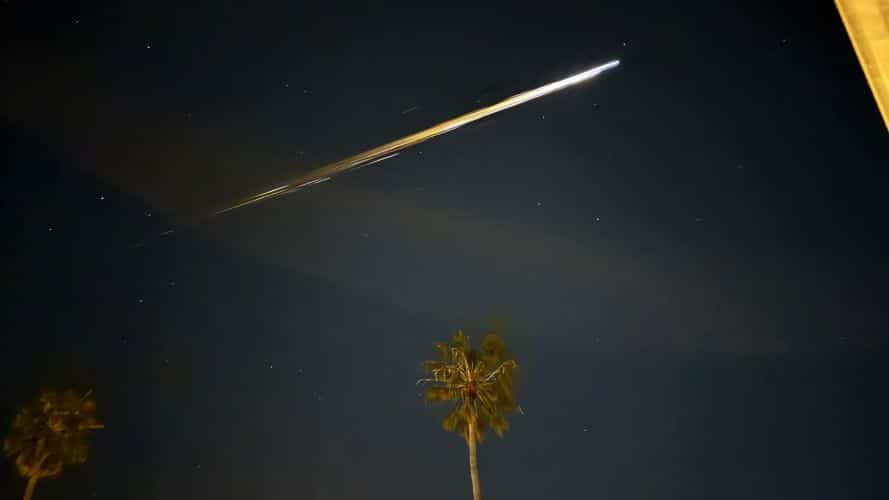Shenzhou-15 Spacecraft Debris Burns Over Los Angeles

On April 2, a spectacular display of fireballs lit up the skies over Los Angeles and parts of central and Southern California. This breathtaking phenomenon quickly sparked curiosity and speculation among onlookers. Later investigations revealed that the dazzling lights were caused by the reentry and disintegration of debris from the Shenzhou-15 spacecraft. Launched by China in November 2022, this incident not only captivated the public but also raised significant concerns about space debris. Additionally, it opened new avenues for tracking and detecting such debris, highlighting the need for improved monitoring systems.
Trajectory Tracked Through Seismic Signals
The reentry of the Shenzhou-15 spacecraft provided a rare opportunity for scientists to study its trajectory using seismic data. Findings presented at the American Geophysical Union’s Annual Meeting in Washington, D.C., revealed how researchers mapped the spacecraft’s path through the atmosphere. Dr. Benjamin Fernando, a planetary scientist at Johns Hopkins University, explained that seismic measurements from various stations across the Los Angeles basin were analyzed to reconstruct the debris’ trajectory. This analysis revealed crucial details about the speed, size, and fragmentation of the object as it traveled inland from the Pacific coast.
The use of seismic data in this context is groundbreaking. Traditionally, tracking space debris has relied on visual observations and radar systems. However, the seismic approach offers a unique perspective, allowing scientists to gather data even when visual tracking is not feasible. This method not only enhances our understanding of the debris’ behavior but also provides valuable insights into its potential impact on populated areas. As the frequency of space missions increases, such innovative tracking techniques become essential for ensuring public safety.
The Role of Seismometers in Space Debris Tracking
The recent event marks one of the first instances where seismometers were used to track space debris without prior notification. Dr. Fernando emphasized the advantages of using seismometers to detect subtle vibrations caused by reentering objects. In regions where visual observations or radar systems may be limited, seismometers can provide critical data. This technology has the potential to predict whether debris poses risks to populated areas, allowing for timely warnings and safety measures.
Seismometers work by detecting ground vibrations, which can be caused by various natural and artificial phenomena. In the case of the Shenzhou-15 debris, these instruments captured the vibrations generated during reentry. This capability opens up new possibilities for monitoring space debris and enhancing our understanding of its behavior. As the global community continues to launch more satellites and spacecraft, the need for effective tracking systems becomes increasingly urgent. Seismometers could play a vital role in ensuring that we can respond to potential threats posed by space debris.
Challenges in Predicting Reentry Paths
Despite the promising applications of seismic data for tracking space debris, challenges remain. Kathleen McKee, a volcano geophysicist at Vanderbilt University, highlighted the complexities involved in using seismic data to track objects moving through a dynamic atmosphere. Factors such as wind and weather conditions can significantly affect the trajectory of reentering debris. These variables complicate efforts to pinpoint the exact path and potential impact zones of such objects.
Moreover, the three-dimensional nature of atmospheric movement adds another layer of difficulty. Accurately predicting the reentry paths of space debris requires sophisticated modeling and analysis. However, the potential benefits of improving public safety and monitoring capabilities make these challenges worth addressing. As researchers continue to refine their techniques, the hope is that seismic data will play a crucial role in enhancing our ability to track and respond to space debris incidents.
Growing Concerns Over Space Debris
The recent event serves as a stark reminder of the increasing hazards posed by space missions and the debris they leave behind. As more countries and private companies launch satellites and spacecraft, the amount of debris in Earth’s orbit continues to grow. Researchers emphasize the importance of innovative detection techniques to mitigate risks to lives and property. The Shenzhou-15 incident demonstrates the potential of seismic technology to enhance global monitoring capabilities.
As the frequency of space debris incidents rises, the need for effective tracking and detection systems becomes more pressing. Researchers are calling for increased investment in technologies that can monitor and predict the behavior of space debris. By developing better tracking systems, we can improve our ability to respond to potential threats and protect both lives and infrastructure. The integration of seismic data into space debris tracking represents a significant step forward in this ongoing effort.
Observer Voice is the one stop site for National, International news, Sports, Editor’s Choice, Art/culture contents, Quotes and much more. We also cover historical contents. Historical contents includes World History, Indian History, and what happened today. The website also covers Entertainment across the India and World.
Follow Us on Twitter, Instagram, Facebook, & LinkedIn

